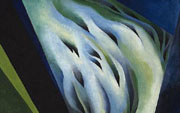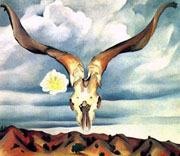-
(单词翻译:双击或拖选)
People in America - Georgia O'Keeffe, 1887-1986: Her Paintings Showed Her Love for the American Southwest
GWEN OUTEN: I’m Gwen Outen.
STEVE EMBER: And I’m Steve Ember with People in America in VOA Special English. Today we tell about one of the greatest painters of the twentieth century, Georgia O'Keeffe.
(MUSIC)
GWEN OUTEN: America has produced many great painters in the past one hundred years. Georgia O'Keeffe is one of the most popular and easily recognized artists. People do not mistake her work for anyone else's. People can immediately identify her paintings of huge, colorful flowers or bones in dream-like deserts.
Georgia O'Keeffe said she did not know how she got the idea to be an artist. But, she said, the idea came early. She remembered announcing when she was twelve years old that she planned to be an artist.
STEVE EMBER: Georgia was born in eighteen eighty-seven, the second of seven children. Her parents were successful farmers in the middle western state of Wisconsin.
 |
| Detail: 'Blue and Green Music' - Georgia O'Keeffe, 1921 |
Georgia's mother also had cultural interests. She made sure that Georgia and her sisters studied art, in addition to their usual school subjects. By the time Georgia was sixteen, the O'Keeffe family had moved to Williamsburg, Virginia.
After Georgia finished school, she attended the Art Institute of Chicago, Illinois. Georgia was especially pleased with the help she got from her teacher, John Vanderpoel. She later wrote that John Vanderpoel was one of the few real teachers she knew.
GWEN OUTEN: In nineteen-oh-seven, O’Keeffe began a year at the Art Students League in New York City. The famous painter William Merritt Chase1 was one of her teachers. Chase had a great influence on O'Keeffe's early artistic2 development. She described him as fresh, full of energy and fierce. She seemed to understand and agree with his style of painting.
Then, in nineteen-oh-eight, Georgia O'Keeffe left the world of fine art. She moved back to Chicago and worked in the advertising3 business. She drew pictures of products to be sold. Her parents had been struggling financially for some time in Virginia. Later, her mother became sick with tuberculosis4. Some art historians5 suspect these were the main reasons Georgia O’Keeffe spent four years in business instead of continuing her studies.
(MUSIC)
STEVE EMBER: In nineteen twelve, O'Keeffe returned to art school at the University of Virginia in Charlottesville. Artist and teacher Arthur Wesley Dow taught that art should fill space in a beautiful way. This theory influenced and changed her work.
O’Keefe also learned6 about the Russian painter Wassily Kandinsky. He wanted artists to represent the inner7 spirit in outer things. O'Keeffe considered Kandinsky's writings a treasure. She read them throughout her life.
GWEN OUTEN: In nineteen fifteen, Georgia O'Keeffe decided8 that much of what she had been taught in art school was of little value. She decided to hang recent work she had done on the wall of her home. She examined it and did not find herself in the art. She wrote that she had been taught to work like others. She decided then that she would not spend her life doing what had already been done.
Georgia O'Keeffe began to search for her own style. She used only charcoal9, the black material made from burned wood. In her book about her life, she wrote that she decided to limit herself to charcoal until she found she really needed color to do what she needed to do. She wrote that six months later she found she needed the color blue. She used it for a watercolor painting she called "Blue Lines."
STEVE EMBER: Georgia O'Keeffe had met the famous art critic and photographer Alfred Stieglitz at his New York City gallery in nineteen-oh-eight. Their friendship grew as they wrote letters to each other. In nineteen fifteen, O'Keeffe told a friend that she wanted her art to please Alfred Stieglitz more than anyone else.
That friend showed O'Keeffe’s charcoal drawings to Stieglitz. Stieglitz liked her drawings enough to show them in his art gallery, called Two Ninety One.
GWEN OUTEN: Alfred Stieglitz was a major force behind shows of Georgia O'Keeffe's work for the next twenty-five years. Her first individual show at his gallery was well received. She sold her first piece at that show in nineteen seventeen.
Stieglitz became O'Keeffe's strongest supporter. Seven years later he became her husband. He was twenty-four years older than his new wife.
The relationship between O’Keeffe and Alfred Stieglitz was not an easy one. O’Keeffe once said that to her “he was much more wonderful in his work than as a human being.” But, she also said she loved him for what seemed “clear and bright and wonderful.” The two remained married until his death in nineteen forty-six.
(MUSIC)
STEVE EMBER: Georgia O'Keeffe also had a long love relationship with the southwestern part of the United States. The desert environment was the subject of many of her paintings. O'Keeffe had moved to the state of Texas when she was twenty-five. She accepted a two-year position as supervisor10 of art in the public schools of Amarillo, Texas.
 |
| 'Ram's Head White Hollyhock and Little Hills' - Georgia O'Keeffe, 1935 |
Later, she taught in a small town. She wrote about long walks on narrow paths in a canyon11 near that town. The dangerous climbs in and out of the canyon were like nothing she had known before. She wrote that many paintings came from experiences like that.
In one such painting, the canyon is shown as a huge deep hole of many colors -- reds, oranges and yellows. It looks as if it is on fire. The canyon fills most of the picture. A small area of blue sky in the distance lends additional12 depth to the picture.
GWEN OUTEN: In nineteen thirty, Georgia O'Keeffe began spending most of her summers in the state of New Mexico. She called it “the faraway.” She painted big pictures of desert flowers and the high rocky hills. She also began to paint pictures of the bones she found during walks near her summer home. Most of her paintings share the qualities of largeness of subject and richness of color.
The artist discussed those two qualities in her book, called “Georgia O’Keefe.” She wrote that color is more exact in meaning than words. Later, she wrote that she found she could say things with color and shape that she could not express in words.
She also spoke13 of a special need to paint her subjects larger than they are in life. She seemed to want to force people to see more deeply into objects such as flowers. She tried to show the different shapes and colors within a single flower. The artist said she would make even busy New Yorkers take time to see what she saw in flowers.
STEVE EMBER: O'Keeffe was angered by some criticism14 of her work over the years. She rejected critics' claims that there was deep sexual15 meaning in her paintings of flowers. She said that people linked their own experience of a flower to her paintings. She suggested that critics wrote about her flower paintings as if they knew what she was seeing and thinking. But, she said, they did not know.
Georgia O'Keeffe always argued that what others think of the artist's work is not important. She once wrote to a friend, "... I'll do as I please."
GWEN OUTEN: Georgia O’Keeffe bought her first house in New Mexico in nineteen forty. After Alfred Stieglitz died, she moved to “the faraway’” permanently16. She lived in New Mexico for the rest of her life.
In the early nineteen seventies, O’Keeffe began losing her sight because of an eye disease17. She stopped working with oil paints, but continued to produce watercolor paintings.
Around the same time, she met a young artist who would become very important to her. Juan Hamilton made pottery18 -- objects of clay. He became O’Keeffe’s assistant and friend. They also traveled together. But in the early nineteen eighties Georgia’s O’Keeffe’s health failed severely19. She died in nineteen eighty-six. She was ninety-eight.
STEVE EMBER: Georgia O’Keefe received many honors20 during her long life. President Gerald Ford21 presented her with the Medal of Freedom in nineteen seventy-seven. Eight years later, President Ronald Reagan awarded her the National Medal of Arts. Students and experts continue to study and write about her work.
Her paintings are shown around the world. And, more than one million people have visited the Georgia O’Keeffe Museum in New Mexico since it opened in nineteen ninety-seven.
(MUSIC)
GWEN OUTEN: This program was written by Caty Weaver22. It was produced by Lawan Davis. I'm Gwen Outen.
STEVE EMBER: And I'm Steve Ember. Listen again next week for People In America in VOA Special English.
 收听单词发音
收听单词发音
1
chase

|
|
| vt.追逐,追赶,追求;n.追赶 | |
参考例句: |
|
|
|
2
artistic

|
|
| adj.艺术(家)的,美术(家)的;善于艺术创作的 | |
参考例句: |
|
|
|
3
advertising

|
|
| n.广告业;广告活动 a.广告的;广告业务的 | |
参考例句: |
|
|
|
4
tuberculosis

|
|
| n.结核病,肺结核 | |
参考例句: |
|
|
|
5
historians

|
|
| n.历史学家,史学工作者( historian的名词复数 ) | |
参考例句: |
|
|
|
6
learned

|
|
| adj.有学问的,博学的;learn的过去式和过去分词 | |
参考例句: |
|
|
|
7
inner

|
|
| adj.内部的,里面的;内在的,内心的;精神的 | |
参考例句: |
|
|
|
8
decided

|
|
| adj.决定了的,坚决的;明显的,明确的 | |
参考例句: |
|
|
|
9
charcoal

|
|
| n.炭,木炭,生物炭 | |
参考例句: |
|
|
|
10
supervisor

|
|
| n.监督人,管理人,检查员,督学,主管,导师 | |
参考例句: |
|
|
|
11
canyon

|
|
| n.峡谷,溪谷 | |
参考例句: |
|
|
|
12
additional

|
|
| adj.添加的,额外的,另外的 | |
参考例句: |
|
|
|
13
spoke

|
|
| n.(车轮的)辐条;轮辐;破坏某人的计划;阻挠某人的行动 v.讲,谈(speak的过去式);说;演说;从某种观点来说 | |
参考例句: |
|
|
|
14
criticism

|
|
| n.批评,批判,指责;评论,评论文章 | |
参考例句: |
|
|
|
15
sexual

|
|
| adj.性的,两性的,性别的 | |
参考例句: |
|
|
|
16
permanently

|
|
| adv.永恒地,永久地,固定不变地 | |
参考例句: |
|
|
|
17
disease

|
|
| n.疾病,弊端 | |
参考例句: |
|
|
|
18
pottery

|
|
| n.陶器,陶器场 | |
参考例句: |
|
|
|
19
severely

|
|
| adv.严格地;严厉地;非常恶劣地 | |
参考例句: |
|
|
|
20
honors

|
|
| n.礼仪;荣典;礼节; 大学荣誉学位;大学优等成绩;尊敬( honor的名词复数 );敬意;荣誉;光荣 | |
参考例句: |
|
|
|
21
Ford

|
|
| n.浅滩,水浅可涉处;v.涉水,涉过 | |
参考例句: |
|
|
|
22
weaver

|
|
| n.织布工;编织者 | |
参考例句: |
|
|
|















